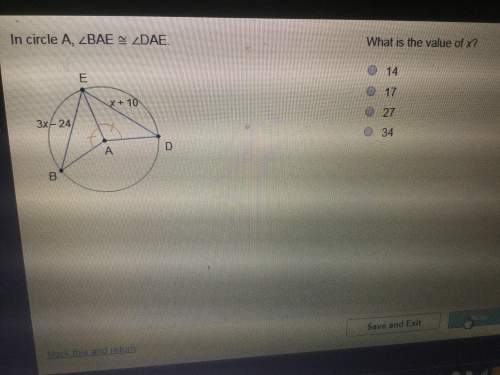
Mathematics, 19.12.2020 01:00 koryn4880
Your father, at the age of 40, purchased a Whole Life insurance policy with a face value of $110,000. The permanent insurance amount for a Whole Life insurance policy for a healthy 40-year-old male is $27.17. Your father decided to terminate the policy at the age of 47. Determine the annual premium and use the table below to determine the value of the Extended term insurance policy.
A 5-column table with 4 rows titled Whole Life Options. Column 1 is labeled End of Year with entries 3, 5, 7, 10. Column 2 is labeled option 1 cash value with entries 7 dollars, 21, 45, 65. Column 3 is labeled option 2 reduced paid-up insurance with entries 18, 50, 96, 150. Column 4 is labeled extended term years with entries 1, 6, 10, 15. Column 5 is labeled Extended term days with entries 180, 15, 40, 200.
a.
Annual Premium of $2,988.7; 10 years and 40 days
c.
Annual Premium of $3,215.33; 6 years and 15 days
b.
Annual Premium of $3,110.12; 15 years and 200 days
d.
Annual Premium of $3,280.78; 1 years and 180 days

Answers: 1


Another question on Mathematics

Mathematics, 21.06.2019 14:30
6.(q^9)^2 a. 2q^18 b. q^18 c. q^81 d.q^11 7.(6q^6)^-4 a. 6q^1296 b. 1296q^2 c. 1/1296q^24 d. 6q^-24 8. what is the value of 12x^-3 y^-1 for x = -1 and y = 5? a. -12/5 b.-10 c.-0 d.5/12 9. (y^-5)^10y^10 a. y^-60 b. y^60 c. y^-150 d. y^150 find the simplified form of each expression. 10. (4/7^5)^2 a.8/14^10 b.16/49^25 c.16/49y^10 d.8/14y^25 11. determine if the number 3.43 times 10^-6 is written in scientific notation. if not, explain. a. yes; the number is written scientific notation. b. no; the first factor is not a number between 1 and 10. c. no; it is not written as a number times a power of 10
Answers: 3

Mathematics, 21.06.2019 15:20
Asmall (but heavy) particle placed in a glass of water will follow a zigzag motion because the particle will bounce off of the water molecules it meets. this is called brownian motion. a physicist simulates this on a computer, by varying the distance a particle can travel (called the mean free length), on average, before it collides with a water molecule and assigning the change in motion to be one of 8 directions, each with a similar probability. by running the simulated particle (with the same mean free length) many times she determines that it should take 15 seconds, on average, for the particle to fall to the bottom, with a standard deviation of 1.5 seconds. next she lets a real particle fall through a glass of water and finds that it took 18 seconds. what does she conclude, and why?
Answers: 1

Mathematics, 21.06.2019 21:30
Zack notices that segment nm and segment pq are congruent in the image below: which step could him determine if δnmo ≅δpqr by sas? (5 points) segment mo ≅ segment qr segment on ≅ segment qp ∠ n ≅ ∠ r ∠ o ≅ ∠ q
Answers: 3

You know the right answer?
Your father, at the age of 40, purchased a Whole Life insurance policy with a face value of $110,000...
Questions



English, 16.10.2020 14:01

Mathematics, 16.10.2020 14:01


World Languages, 16.10.2020 14:01


Chemistry, 16.10.2020 14:01




English, 16.10.2020 14:01

Chemistry, 16.10.2020 14:01

History, 16.10.2020 14:01

Geography, 16.10.2020 14:01


English, 16.10.2020 14:01

History, 16.10.2020 14:01

English, 16.10.2020 14:01





